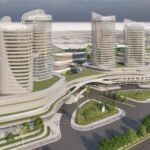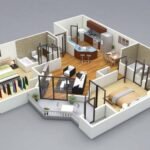The world of industrial design is changing fast. New technologies, a focus on sustainability, and changes in work life are driving this change. Modern architecture is adapting to these shifts, leading to smart, green, and flexible industrial spaces.
These new spaces use the latest IoT and AI tech. They also use eco-friendly materials and designs that can change. This new era is reshaping our built world.
Important trends in modern industrial facilities include smart factories and green materials. There’s also a move towards modular construction for flexibility. And, spaces are being designed to make workers happy and healthy.
These changes are making industrial buildings more efficient and green. They also make these spaces better for people to work in.
Key Takeaways
- Industrial design is evolving due to technological advancements, sustainability concerns, and changing work dynamics.
- Key trends include smart factories, sustainable materials, flexible spaces, and employee-centric design.
- These trends are leading to more efficient, sustainable, and adaptable industrial buildings that respond to user needs and environmental contexts.
- Architects and designers play a crucial role in shaping the future of industrial spaces, integrating cutting-edge technologies and sustainability principles.
- The focus on employee well-being and community integration is transforming the industrial landscape, creating more livable and engaging environments.
Evolution of Industrial Design: From Revolution to Modern Era
The Industrial Revolution in the late 1700s changed architecture a lot. It introduced steel, concrete, and bricks into building. At first, factories were just about getting work done, not looking good. But by the late 1960s, old warehouses and factories were seen in a new light. They were valued for their open spaces and industrial look, starting the Industrial Chic movement.
The Birth of Industrial Architecture
In the Industrial Revolution’s peak, factories focused on being efficient and productive. They didn’t care much about looks. But as people’s views changed, these buildings were given new life. Now, they’re part of modern designs, mixing old and new with exposed beams and raw materials.
Transformation from Factories to Modern Spaces
Old factories and warehouses are now lively, flexible spaces. They’re used as offices, lofts, and cultural spots. Their big rooms and lots of light make them perfect for new uses. This change keeps the buildings’ history alive while making them fresh and exciting.
Impact of Technology on Design Evolution
Technology has greatly shaped industrial design. New materials and building methods let architects build stronger, taller buildings. Smart systems like energy-saving HVAC and automated controls have also changed how we use these spaces. As tech keeps advancing, we’ll see even more changes in how we design and use industrial spaces.
“The industrial revolution was the greatest discontinuity in human experience. It upended every aspect of human life and irreversibly changed the planet.”
– Jeremy Rifkin, American economic and social theorist
Smart Technologies Reshaping Architectural Spaces

The world of architecture is changing fast, thanks to smart technologies. The Internet of Things (IoT), Artificial Intelligence (AI), and digital fabrication are changing how we design and manage buildings.
IoT and AI are making buildings more efficient. IoT-connected thermostats can save up to 23% on energy. AI can save up to 20% on energy too. These systems use resources better, predict when things need fixing, and keep buildings safe.
Building Information Modeling (BIM) is also a big deal. It makes designing and building easier. BIM cuts down on mistakes and keeps projects on time. It also lets architects try new ideas, making buildings more innovative.
Technologies like 3D printing are changing how buildings are made. 3D printing makes building parts faster and cheaper. It lets architects be more creative and flexible.
These smart technologies help architects make buildings that work better. IoT systems adjust to how many people are around and the weather. This makes buildings use less energy and saves money for owners. Plus, buildings are becoming greener, using less water and energy.
The future of buildings is bright, thanks to smart tech, green design, and thinking about people. As these ideas grow, we’ll see buildings that are smarter, more efficient, and better for us.
“The integration of technology in architecture advances the field of smart homes, fostering innovation, sustainability, and efficiency.”
Industrial Design in Contemporary Architecture

Modern architecture is evolving fast, and industrial design plays a big role. It brings new ideas and helps us use resources better. Now, we see eco-friendly materials everywhere. Green roofs and solar panels are also common in new buildings.
Digital tools like 3D printing and parametric design have changed how we design. They help create complex shapes and details easily. This makes it cheaper and faster to turn ideas into real buildings.
Material Innovation and Sustainability
Sustainability is key in today’s industrial architecture. Designers use eco-friendly materials like recycled plastics and bamboo. They also add green roofs and solar panels to cut down on energy use and pollution.
Digital Fabrication Technologies
3D printing and parametric design are game-changers. They let us make unique, complex parts and even whole buildings. This opens up new possibilities in architecture.
Integration of Smart Systems
Modern buildings now have smart systems. These use sensors and algorithms to adjust to the environment and user needs. They make buildings more energy-efficient, comfortable, and useful.
The mix of industrial design and modern architecture will lead to more creative and green solutions. This will shape our future buildings.
| Statistic | Value |
|---|---|
| Number of Industrial Designers in the US | Over 29,500 |
| Median Annual Salary for Industrial Designers | $77,030 |
| Top States for Industrial Design Jobs | California, Michigan, New York |
“The demand for aesthetically pleasing manufactured products had grown to a point where it could no longer be underestimated, leading to increased interest in modern design and collaboration between artists and industry.”
Sustainable Design Principles and Green Innovation
Sustainable design is key in modern industrial architecture. Architects aim to cut down environmental harm. They do this by making buildings energy-efficient, using eco-friendly materials, and following the circular economy.
Green innovations are also important. These include using recycled materials, energy-generating walls, and smart waste systems. Today, industrial buildings are designed to last, being both useful and good for the planet.
Nestlé is a big name in food and drinks, leading in sustainability. They aim to be carbon-neutral by 2050. Their plan includes sustainable sourcing, better packaging, and using renewable energy.
The move to sustainable design and innovation is vital. Most of a product’s environmental impact is set in the design stage. Many countries and big companies are setting net-zero targets, showing sustainability’s growing role.
For sustainable success, planning and teamwork are key. Companies need strong leadership and clear goals. This ensures they can meet their green promises.
Also Read : How To Achieve The Scandinavian Aesthetic In Your Home
FAQs
Q: What is an industrial design degree and what does it entail?
A: An industrial design degree focuses on the study of creating and developing product designs that are both functional and aesthetically pleasing. This degree program includes courses in art and design, design research, and the design process, preparing students for a career as industrial designers.
Q: What skills do industrial designers typically possess?
A: Industrial designers typically possess skills in creativity, problem-solving, and technical proficiency in design software. They also have a strong understanding of materials and manufacturing processes, which are essential for effective product design.
Q: How does the design process work in industrial design?
A: The design process in industrial design involves several stages, including research, ideation, prototyping, and testing. This iterative process helps ensure that the final product meets user needs and is feasible for production.
Q: What is the significance of an industrial design program?
A: An industrial design program provides students with the foundational knowledge and skills necessary to succeed in the industrial design profession. These programs often include hands-on experience in design studios and collaborative projects with design teams.
Q: What career opportunities are available for graduates of an industrial design degree?
A: Graduates of an industrial design degree can pursue various career paths, including roles as industrial designers, product designers, or design researchers. They may work for design firms, manufacturing companies, or even start their own design studios.
Q: What are the differences between industrial design and graphic design?
A: Industrial design focuses on creating three-dimensional products that are functional and user-friendly, while graphic design emphasizes visual communication through two-dimensional media. Both fields require creativity and an understanding of design principles, but they differ in their applications and outcomes.
Q: How does the Department of Industrial Design support students in their education?
A: The Department of Industrial Design offers resources such as design studios, access to industry-standard software, and opportunities for collaboration with the industrial designers society of america. These resources enhance the design education experience and prepare students for their future careers.
Q: What role does prototyping play in the industrial design process?
A: Prototyping is a crucial step in the industrial design process as it allows designers to create tangible models of their concepts. This helps in testing the functionality and aesthetics of the design before moving into production, ensuring that the result of a design process meets the intended criteria.
Q: What should I look for when choosing a school of industrial design?
A: When choosing a school of industrial design, consider factors such as the curriculum offered, faculty expertise, facilities available (like design studios), industry connections, and the overall reputation of the program within the association of schools of art and the national association of schools.





